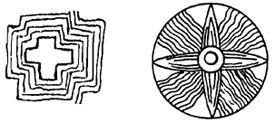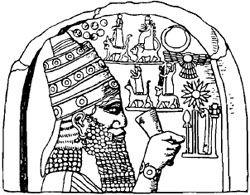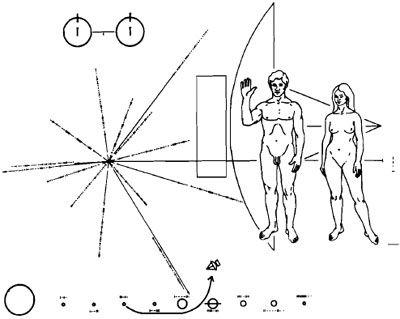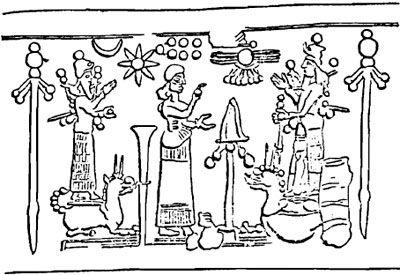The 12th Planet (41 page)
Authors: Zecharia Sitchin
Tags: #Non-Fiction, #Gnostic Dementia, #Fringe Science, #Retail, #Archaeology, #Ancient Aliens, #History

When the Earthlings
began to increase in number
upon the face of the Earth,
and daughters were born unto them.
This, the narrative continues, was the time when
The sons of the gods
saw the daughters of the Earthling
that they were compatible;
and they took unto themselves
wives of whichever they chose.
It was the time when
The Nefilim were upon the land
in those days, and thereafter too;
when the sons of the gods
cohabited with the Earthling's daughters
and they conceived.
They were the Mighty Ones who are of Olam,
the People of the
Shem.
It was then, in those days, at that time that Man was about to be wiped off the face of the Earth by the Flood.
When exactly was that?
Verse 3 tells us unequivocally: when his, the Deity's count, was 120 years. One hundred twenty "years," not of Man and not of Earth, but as counted by the mighty ones, the "People of the Rockets," the Nefilim. And their year was the
shar—3,600
Earth years.
This interpretation not only clarifies the perplexing verses of Genesis 6, it also shows how the verses match the Sumerian information: 120
shars,
432,000 Earth years, had passed between the Nefilim's first landing on Earth and the Deluge.
Based on our estimates of when the Deluge occurred, we place the first landing of the Nefilim on Earth circa 450,000 years ago.
•
Before we turn to the ancient records regarding the voyages of the Nefilim to Earth and their settlement on Earth, two basic questions need to be answered: Could beings obviously not much different from us evolve on another planet? Could such beings have had the capability, half a million years ago, for interplanetary travel?
The first question touches upon a more fundamental question: Is there life as we know it anywhere besides the planet Earth? Scientists now know that there are innumerable galaxies like ours, containing countless stars like our Sun, with astronomical numbers of planets providing every imaginable combination of temperature and atmosphere and chemicals, offering billions of chances for Life.
They have also found that our own interplanetary space is not void. For example, there are water molecules in space, the remnants of what are believed to have been clouds of ice crystals that apparently envelop stars in their early stages of development. This discovery lends support to persistent Mesopotamian references to the waters of the Sun, which mingled with the waters of Tiamat.
The basic molecules of living matter have also been found "floating" in interplanetary space, and the belief that life can exist only within certain atmospheres or temperature ranges has also been shattered. Furthermore, the notion that the only source of energy and heat available to living organisms is the Sun's emissions has been discarded. Thus, the spacecraft
Pioneer 10
discovered that Jupiter, though much farther away from the Sun than Earth, was so hot that it must have its own sources of energy and heat.
A planet with an abundance of radioactive elements in its depths would not only generate its own heat; it would also experience substantial volcanic activity. Such volcanic activity provides an atmosphere. If the planet is large enough to exert a strong gravitational pull, it will keep its atmosphere almost indefinitely. Such an atmosphere, in turn, creates a hothouse effect: it shields the planet from the cold of outer space, and keeps the planet's own heat from dissipating into space—much as clothing keeps us warm by not letting the body's heat dissipate. With this in mind, the ancient texts' descriptions of the Twelfth Planet as "clothed with a halo" assume more than poetic significance. It was always referred to as a radiant planet
—
"most radiant of the gods he is"
—
and depictions of it showed it as a ray-emitting body. The Twelfth Planet could generate its own heat and retain the heat because of its atmospheric mantle. (Fig. 115)

Fig. 115
Scientists have also come to the unexpected conclusion that not only could life have evolved upon the outer planets (Jupiter, Saturn, Uranus, Neptune) but it probably
did
evolve there. These planets are made up of the lighter elements of the solar system, have a composition more akin to that of the universe in general, and offer a profusion of hydrogen, helium, methane, ammonia, and probably neon and water vapor in their atmospheres
—
all the elements required for the production of organic molecules.
For life as we know it to develop, water is essential. The Mesopotamian texts left no doubt that the Twelfth Planet was a watery planet. In the "Epic of Creation," the planet's list of fifty names included a group exalting its watery aspects. Based on the epithet A.SAR ("watery king"), "who established water levels," the names described the planet as A.SAR. U ("lofty, bright watery king"), A.SAR.U.LU.DU ("lofty, bright watery king whose deep is plentiful"), and so on.
The Sumerians had no doubt that the Twelfth Planet was a verdant planet of life; indeed, they called it NAM.TIL.LA.KU, "the god who maintains life." He was also "bestower of cultivation," "creator of grain and herbs who causes vegetation to sprout ... who opened the wells, apportioning waters of abundance"
—
the "irrigator of Heaven and Earth."
Life, scientists have concluded, evolved not upon the terrestrial planets, with their heavy chemical components, but in the outer fringes of the solar system. From these fringes of the solar system, the Twelfth Planet came into our midst, a reddish, glowing planet, generating and radiating its own heat, providing from its own atmosphere the ingredients needed for the chemistry of life.
If a puzzle exists, it is the appearance of life on Earth. Earth was formed some 4,500,000,000 years ago, and scientists believe that the simpler forms of life were already present on Earth within a few hundred million years thereafter. This is simply much too soon for comfort. There are also several indications that the oldest and simplest forms of life, more than 3,000,000,000 years old, had molecules of a biological, not a nonbiological, origin. Stated differently, this means that the life that was on Earth so soon after Earth was born was itself a descendant of some previous life form, and
not
the result of the combination of lifeless chemicals and gases.
What all this suggests to the baffled scientists is that life, which could not easily evolve on Earth, did not, in fact, evolve on Earth. Writing in the scientific magazine
Icarus
(September 1973), Nobel Prize winner Francis Crick and Dr. Leslie Orgel advanced the theory that "life on Earth may have sprung from tiny organisms from a distant planet."
They launched their studies out of the known uneasiness among scientists over current theories of the origins of life on Earth. Why is there only
one
genetic code for all terrestrial life? If life started in a primeval "soup," as most biologists believe, organisms with a variety of genetic codes should have developed. Also, why does the element molybdenum playa key role in enzymatic reactions that are essential to life, when molybdenum is a very rare element? Why are elements that are more abundant on Earth, such as chromium or nickel, so unimportant in biochemical reactions?
The bizarre theory offered by Crick and Orgel was not only that all life on Earth may have sprung from an organism from another planet but that such "seeding" was
deliberate—that
intelligent beings from another planet launched the "seed of life" from their planet to Earth in a spaceship, for the express purpose of starting the life chain on Earth.
Without benefit of the data provided by this book, these two eminent scientists came close to the real fact. There was no premeditated "seeding"; instead, there was a celestial collision. A life-bearing planet, the Twelfth Planet and its satellites, collided with Tiamat and split it in two, "creating" Earth of its half.
During that collision the life-bearing soil and air of the Twelfth Planet "seeded" Earth, giving it the biological and complex early forms of life for whose early appearance there is no other explanation.
If life on the Twelfth Planet started even 1 percent sooner than on Earth, then it began there some 45,000,000 years earlier. Even by this minute margin, beings as developed as Man would already have been living upon the Twelfth Planet when the first small mammals had just begun to appear on Earth.
Given this earlier start for life on the Twelfth Planet, it was possible for its people to be capable of space travel a mere 500,000 years ago.
9
•
LANDING ON PLANET EARTH
We have set foot only on the Moon, and have probed only the planets closest to us with unmanned craft. Beyond our relatively close neighbors, both interplanetary and outer space are still outside the reach of even small scanning craft. But the Nefilim's own planet, with its vast orbit, has served as a traveling observatory, taking them through the orbits of all the outer planets and enabling them to observe at first hand most of the solar system.
No wonder, then, that when they landed on Earth, a good deal of the knowledge they brought with them concerned astronomy and celestial mathematics. The Nefilim, "Gods of Heaven" upon Earth, taught Man to look up unto the heavens
—
just as Yahweh urged Abraham to do.
No wonder, too, that even the earliest and crudest sculptures and drawings bore celestial symbols of constellations and planets; and that when the gods were to be represented or invoked, their celestial symbols were used as a graphic shorthand. By invoking the celestial ("divine") symbols, Man was no longer alone; the symbols connected Earthlings with the Nefilim, Earth with Heaven, Mankind with the universe.
Some of the symbols, we believe, also convey information that could be related only to space travel to Earth.
Ancient sources provide a profusion of texts and lists dealing with the celestial bodies and their associations with the various deities. The ancient habit of assigning several epithet names to both the celestial bodies and the deities has made identification difficult. Even in the case of established identifications, such as Venus/lshtar, the picture is confused by the changes in the pantheon. Thus, in earlier times Venus was associated with Nin
h
ursag.
Somewhat greater clarity has been obtained by scholars, such as E. D. Van Buren
(Symbols of the Gods in Mesopotamian Art),
who assembled and sorted out the more than eighty symbols
—
of gods and celestial bodies
—
that can be found on cylinder seals, sculptures, stelae, reliefs, murals, and (in great detail and clarity) on boundary stones
(kudurru
in Akkadian). When the classification of the symbols is made, it becomes evident that apart from standing for some of the better-known southern or northern constellations (such as the Sea Serpent for the constellation Hydra), they represented either the
twelve
constellations of the zodiac (for example, the Crab for Scorpio), or the
twelve
Gods of Heaven and Earth, or the
twelve
members of the solar system. The
kudurru
set up by Melishipak, king of Susa (see p. 186), shows the twelve symbols of the zodiac and the symbols of the twelve astral gods.
A stela erected by the Assyrian king Esarhaddon shows the ruler holding the Cup of Life while facing the twelve chief Gods of Heaven and Earth. We see four gods atop animals, of whom Ishtar on the lion and Adad holding the forked lightning can definitely be identified. Four other gods are represented by the tools of their special attributes, as the war-god Ninurta by his lion-headed mace. The remaining four gods are shown as celestial bodies
—
the Sun (Shamash), the Winged Globe (the Twelfth Planet, the abode of Anu), the Moon's crescent, and a symbol consisting of seven dots. (Fig. 116)

Fig. 116
Although in later times the god Sin was associated with the Moon, identified by the crescent, ample evidence shows that in "olden times" the crescent was the symbol of an elderly and bearded deity, one of Sumer's true "olden gods." Often shown surrounded by streams of water, this god was undoubtedly Ea. The crescent was also associated with the science of measuring and calculating, of which Ea was the divine master. It was appropriate that the God of the Seas and Oceans, Ea, be assigned as his celestial counterpart the Moon, which causes the ocean's tides.
What was the meaning of the symbol of the seven dots?
Many clues leave no doubt that it was the celestial symbol of Enlil. The depiction of the Gateway of Anu (the Winged Globe) flanked by Ea and Enlil (see Fig. 87), represents them by the crescent and the seven-dot symbol. Some of the clearest depictions of the celestial symbols that were meticulously copied by Sir Henry Rawlinson
(The Cuneiform Inscriptions of Western Asia)
assign the most prominent position to a group of three symbols, standing for Anu flanked by his two sons; these show that the symbol for Enlil could be either the seven dots or a seven-pointed "star." The essential element in Enlil's celestial representation was the number
seven
(the daughter, Nin
h
ursag, was sometimes included, represented by the umbilical cutter). (Fig. 117)

Fig. 117
Scholars have been unable to understand a statement by Gudea, king of Lagash, that "the celestial 7 is 50." Attempts at arithmetic solutions
—
some formula whereby the number seven would go into fifty
—
failed to reveal the meaning of the statement. However, we see a simple answer: Gudea stated that the celestial body that is "seven" stands for the god that is "fifty." The god Enlil, whose rank number was fifty, had as his celestial counterpart the planet that was seventh.
Which planet was the planet of Enlil? We recall the texts that speak of the early times when the gods first came to Earth, when Anu stayed on the Twelfth Planet, and his two sons who had gone down to Earth drew lots. Ea was given the "rulership over the Deep," and to Enlil "the Earth was given for his dominion." And the answer to the puzzle bursts out in all its significance:
The planet of Enlil was Earth. Earth
—
to the Nefilim
—
was the seventh planet.
•
In February 1971, the United States launched an unmanned spacecraft on the longest mission to date. For twenty-one months it traveled, past Mars and the asteroid belt, to a precisely scheduled rendezvous with Jupiter. Then, as anticipated by NASA scientists, the immense gravitational pull of Jupiter "grabbed" the spacecraft and hurled it into outer space.
Speculating that
Pioneer 10
might someday be attracted by the gravitational pull of another "solar system" and crash-land on some planet elsewhere in the universe, the
Pioneer 10
scientists attached to it an engraved aluminum plaque bearing the accompanying "message." (Fig. 118)

Fig. 118
The message employs a pictographic language—signs and symbols not too different from those used in the very first pictographic writing of Sumer. It attempts to tell whoever might find the plaque that Mankind is male and female, of a size related to the size and shape of the spacecraft. It depicts the two basic chemical elements of our world, and our location relative to a certain interstellar source of radio emissions. And it depicts our solar system as a Sun and nine planets, telling the finder: "The craft that you have found comes from the
third
planet of this Sun."
Our astronomy is geared to the notion that Earth is the third planet—which, indeed, it is if one begins the count from the center of our system, the Sun.
But to someone nearing our solar system
from the outside,
the first planet to be encountered would be Pluto, the second Neptune, the third Uranus—not Earth. Fourth would be Saturn; fifth, Jupiter; sixth, Mars.
And Earth would be
seventh.
•
No one but the Nefilim, traveling to Earth past Pluto, Neptune, Uranus, Saturn, Jupiter, and Mars, could have considered Earth "the seventh." Even if, for the sake of argument, one assumed that the inhabitants of ancient Mesopotamia, rather than travelers from space, had the knowledge or wisdom to count Earth's position not from the central Sun but from the solar system's edge, then it would follow that the ancient peoples
knew
of the existence of Pluto and Neptune and Uranus. Since they could not have known of these outermost planets on their own, the information must, we conclude, have been imparted to them by the Nefilim.
Whichever assumption is adopted as a starting point, the conclusion is the same: Only the Nefilim could have known that there are planets beyond Saturn, as a consequence of which Earth—counting from the outside—is the seventh.
Earth is not the only planet whose numerical position in the solar system was represented symbolically. Ample evidence shows that Venus was depicted as an eight-pointed star: Venus is the eighth planet, following Earth, when counted from the outside. The eight-pointed star also stood for the goddess Ishtar, whose planet was Venus. (Fig. 119)
Many cylinder seals and other graphic relics depict Mars as the sixth planet. A cylinder seal shows the god associated with Mars (originally Nergal, then Nabu), seated on a throne under a six-pointed "star" as his symbol. (Fig. 120) Other symbols on the seal show the Sun, much in the same manner we would depict it today; the Moon; and the cross, symbol of the "Planet of Crossing," the Twelfth Planet.
In Assyrian times, the "celestial count" of a god's planet was often indicated by the appropriate number of star symbols placed alongside the god's throne. Thus, a plaque depicting the god Ninurta placed four star symbols at his throne. His planet Saturn is indeed the fourth planet, as counted by the Nefilim. Similar depictions have been found for most of the other planets.
•
The central religious event of ancient Mesopotamia, the twelve-day New Year Festival, was replete with symbolism that had to do with the orbit of the Twelfth Planet, the makeup of the solar system, and the journey of the Nefilim to Earth. The best-documented of these "affirmations of the faith" were the Babylonian New Year rituals; but evidence shows that the Babylonians only copied traditions going back to the beginning of Sumerian civilization.

